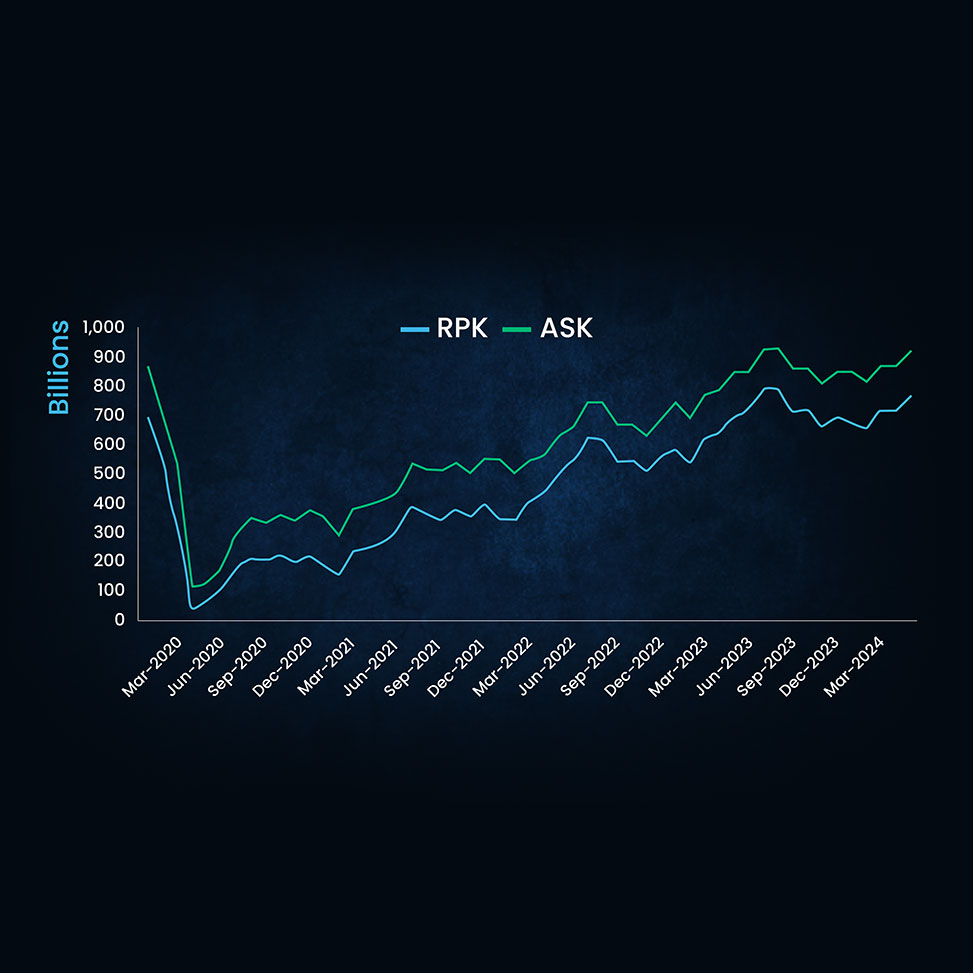Air traffic metrics are crucial indicators of market dynamics, operational efficiency, and demand trends. For flight operators, these metrics enable data-driven planning that maximizes revenue, optimizes resource allocation, and improves service delivery. By examining both passenger and cargo metrics in detail, operators can gain a comprehensive understanding of their impact on aviation operations.
Passenger Traffic Metrics: Evaluating Market Demand and Operational Capacity
Passenger traffic metrics gauge both the demand for air travel and the airline’s ability to meet this demand. The core metrics include Revenue Passenger Kilometers (RPK), Available Seat Kilometers (ASK), Passenger Load Factor (PLF), and Passenger Numbers (PAX). Each reveals different aspects of the airline’s operational performance and market positioning.
1. Revenue Passenger Kilometers (RPK): A Barometer of Market Demand
RPK measures the actual volume of passenger traffic by combining the number of revenue-generating passengers with the distance they travel. It provides a direct indicator of demand for air travel across an airline’s network. For example, if an airline carries 150 passengers on a 2,000-kilometer route, the RPK for that flight is 300,000 (150 passengers × 2,000 km).
A significant year-over-year increase in RPK, such as from 5 billion to 6 billion RPKs, would indicate growing demand—potentially driven by factors like economic growth, increased tourism, or new service routes. Analyzing these trends helps flight operators identify growth markets and evaluate the success of demand generation strategies.
2. Available Seat Kilometers (ASK): A Measure of Operational Capacity
ASK represents the total capacity offered for passenger travel, calculated by multiplying the number of seats available by the distance flown. For example, if an airline has a 180-seat aircraft flying a 1,500-kilometer route, the ASK for that flight is 270,000 (180 seats × 1,500 km).
Tracking ASK trends allows flight operators to monitor how capacity changes over time, such as adding flights or deploying larger aircraft. If ASK increases by 10% from one month to the next while RPK only grows by 5%, it could suggest that capacity is outpacing demand, potentially leading to lower load factors.

3. Passenger Load Factor (PLF): Evaluating Seat Utilization Efficiency
Passenger Load Factor measures the efficiency of seat utilization by dividing RPK by ASK. It represents the percentage of available seating capacity that is occupied by passengers. For instance, if an airline has 200,000 RPKs and 250,000 ASKs on a given route, the PLF would be 80% (200,000 ÷ 250,000 × 100).
A high PLF, such as 90%, indicates strong seat occupancy and efficient capacity utilization, which typically translates to higher profitability. Conversely, a PLF of 60% may signal underutilization, prompting an airline to consider adjusting schedules, downsizing aircraft, or implementing targeted operation campaigns.
4. Passenger Numbers (PAX): Basic Traffic Volume Indicator
PAX reflects the total number of passengers transported over a specified period. Although less detailed than RPK or PLF, it serves as a quick reference for passenger volume trends. For instance, if an airline carried 1.5 million passengers last month compared to 1.2 million in the same month last year, it shows a year-over-year growth rate of 25%. This growth, when combined with metrics like PLF and RPK, can help flight operators assess whether capacity changes are being effectively absorbed by the operations.
Cargo Traffic Metrics: Analyzing Freight Dynamics and Operational Capacity
Air cargo metrics offer insights into freight services and mixed passenger-cargo operations. Important metrics include Cargo Tonne Kilometers (CTK), Available Cargo Tonne Kilometers (ACTK), and Cargo Load Factor (CLF).
1. Cargo Tonne Kilometers (CTK): Gauging Freight Traffic Volume
CTK measures the volume of cargo transported by considering both weight and distance. For example, if an airline transports 10 tonnes of cargo on a 3,000-kilometer route, the CTK would be 30,000 (10 tonnes × 3,000 km). A rise in CTK from 500,000 to 600,000 may indicate increased demand for air freight, possibly driven by growth in e-commerce or urgent shipments in sectors like pharmaceuticals.
2. Available Cargo Tonne Kilometers (ACTK): Measuring Cargo Capacity
ACTK represents the total cargo-carrying capacity available across the airline’s network. Calculated by multiplying the available cargo capacity by the distance flown, it helps operators understand whether capacity aligns with freight demand. For instance, if an airline has 15 tonnes of available capacity on a 2,000-kilometer flight, the ACTK would be 30,000 (15 tonnes × 2,000 km). Comparing ACTK with CTK helps determine if the airline is efficiently utilizing its cargo capacity.
3. Cargo Load Factor (CLF): Cargo Utilization Efficiency
CLF measures the percentage of available cargo space that is filled, calculated as CTK divided by ACTK. For example, if an airline achieves 40,000 CTK out of 50,000 ACTK, the CLF would be 80% (40,000 ÷ 50,000 × 100). High CLF indicates efficient cargo utilization, while a low CLF could prompt adjustments to cargo services, such as focusing on high-yield freight or reducing capacity on underperforming routes.
Combined Metrics: Assessing Total Operational Capacity
For airlines operating both passenger and cargo services, Available Tonne Kilometers (ATK) offers a unified view of total capacity. This metric accounts for both passenger and cargo transport by converting passenger capacity into equivalent weight. If an airline’s combined passenger and cargo capacity totals 25 tonnes on a 1,800-kilometer flight, the ATK would be 45,000 (25 tonnes × 1,800 km). Monitoring ATK alongside PLF and CLF allows operators to optimize aircraft allocation, ensuring balanced capacity utilization.
Applying Air Traffic Metrics to Operational Strategy
Flight operators can use air traffic metrics for various strategic applications:
Route Planning and Network Optimization
By examining RPK and CTK growth patterns, flight operators can identify high-potential markets and decide where to allocate resources. For instance, if RPK shows a 15% year-over-year increase on a particular route, it might be a candidate for additional flights. Conversely, if CTK declines by 10%, it may indicate an oversaturated freight market, suggesting the need for schedule adjustments.
Seasonal Capacity Management
Metrics like PLF and CLF can guide capacity adjustments during peak seasons, such as increasing flights on high-demand routes during holidays or scaling back cargo operations during economic slowdowns. For example, if PLF reaches 95% during a summer travel surge, it may signal the need for more frequent flights to accommodate increased passenger demand.
Revenue Management and Financial Forecasting
Air traffic metrics form the basis of revenue forecasting and financial planning, helping operators anticipate revenue streams based on expected traffic volumes. If RPK is projected to grow by 20% in the next quarter, operators can adjust pricing strategies or introduce additional capacity to maximize profitability.
By integrating these metrics into decision-making processes, flight operators can transform raw data into actionable insights, enhancing operational efficiency, improving resource management, and achieving greater profitability in competitive operations.
At Just Aviation, we provide tailored business flight support services that empower operators to optimize air traffic management. Our expertise in analyzing key metrics such as Revenue Passenger Kilometers (RPK), Passenger Load Factor (PLF), and Cargo Tonne Kilometers (CTK) ensures that you can make data-driven decisions to enhance route planning, capacity management, and revenue forecasting. With our support, your operations achieve the precision needed to navigate the complexities of modern aviation.
